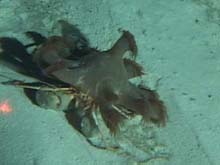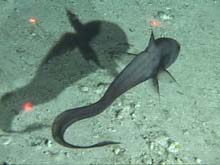
A hermit crab with a big invertebrate on its back. Crabs with anemones on their backs are relatively common, but this is an unusual-looking “rider”. No one on board can identify the species. Click image for larger view.
Rare Finds
September 20, 2002
Rachel Shackelford, Data Manager
Hawaii Undersea Research Lab (HURL)
We now have two Pisces IV dives under our belts at Northampton Seamounts. Based on the initial dive in the remotely operated vehicle (ROV), it appeared that few fish or coral inhabited the depths where monk seals forage (300-400 m). The observations from the submersible support that notion. In fact, the most interesting fish are showing up below 800 m.
The steep slopes of these seamounts allow the sub to initially drop down to 800 or 1,000 m and then work its way up to the target depth range of 300-400 m. Two fish in the Bathygadid family, and probably the Gadomus genus, showed up in the first hour of yesterday's dive. These fish are very rare; only one species within the Gadomus genus has been documented in Hawaii. These images are definitely important records for the HURL archive, and we will have some specialists look at them to see if they are something new. We also got an image of a hermit crab (Pagrurid family) with an ornate cnidarian on its back. At first glance, it looks like a common anemone crab, but when you look closer, you see that all the “anemones” are joined together as one organism. Maybe it is a soft coral, or something of that nature, on the crab's back. Again, we'll need a specialist to tell us more. The fisheries biologists on board are excited every time we get an image of something rare or hard to identify.

Rare fish in the Bathygadid family. The fisheries biologists on board the KOK are not sure what species it is, but they think it may be in the Gadomus genus. Supposedly, there are only two genus of this family in Hawaii and only one Gadomus species (G. melanopterus) has been seen in Hawai‘i. This will be a new record for the HURL group. Click image for larger view.
One of the more exciting fish seen on today's dive was the spectacular Grammatonotus macrophthalmus. This beautiful purple and yellow fish was first seen in Hawaii on one of HURL's fisheries dives at French Frigate Shoals last year. Biologists thought that the single sighting may have been a fluke, since they had been diving in that area for years without ever having seen one. Today, they saw about 10 of them! I guess they are more common than researchers thought.
It's not clear why we aren't seeing more fish and corals in the 300-400 m range. Frank Parrish, a fisheries biologist from NOAA's National Marine Fisheries Service, has a few ideas. Perhaps more ideas will be generated by our dives on the second (western) Northampton Seamount. We will start mapping it tonight, and will dive on it tomorrow.




















